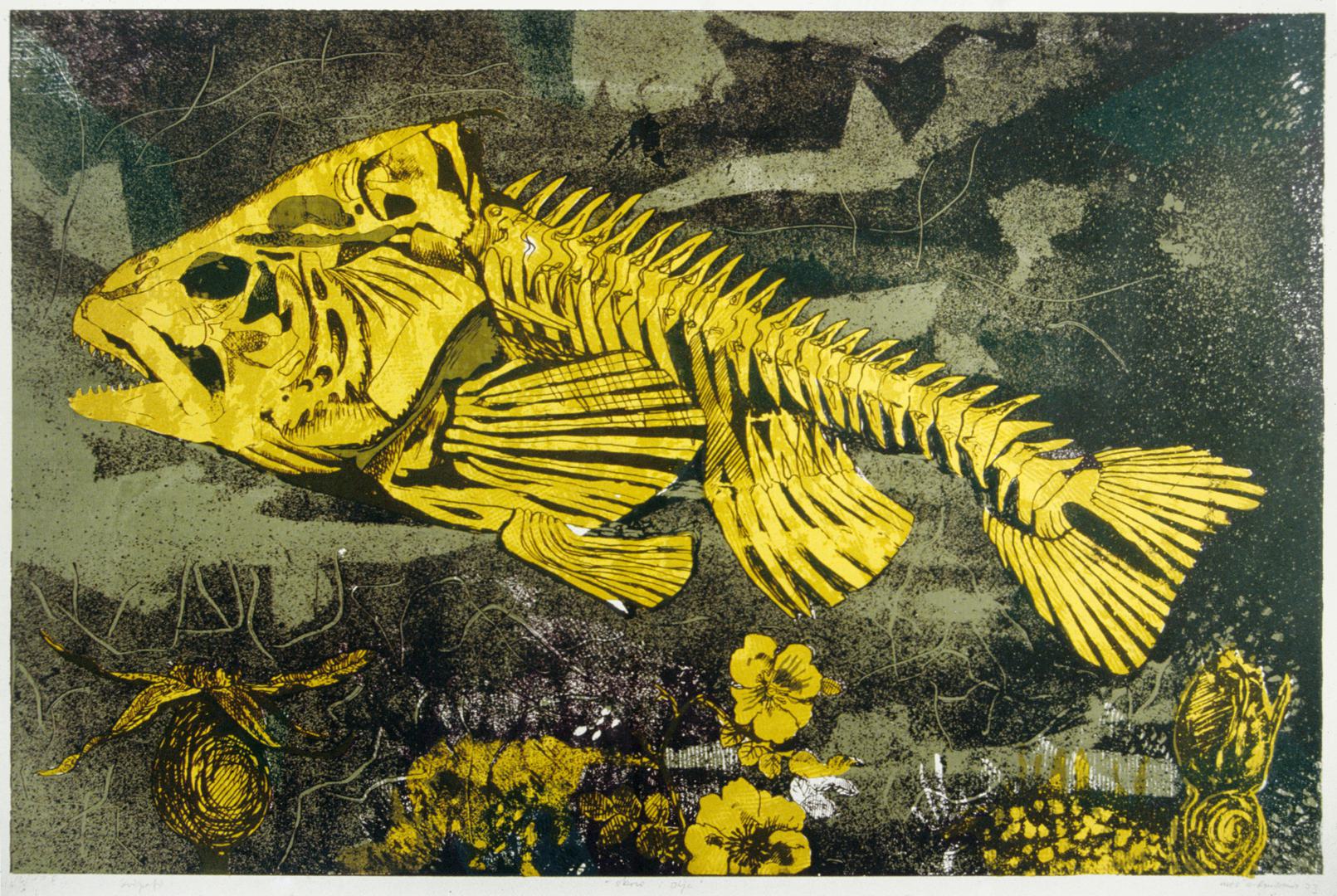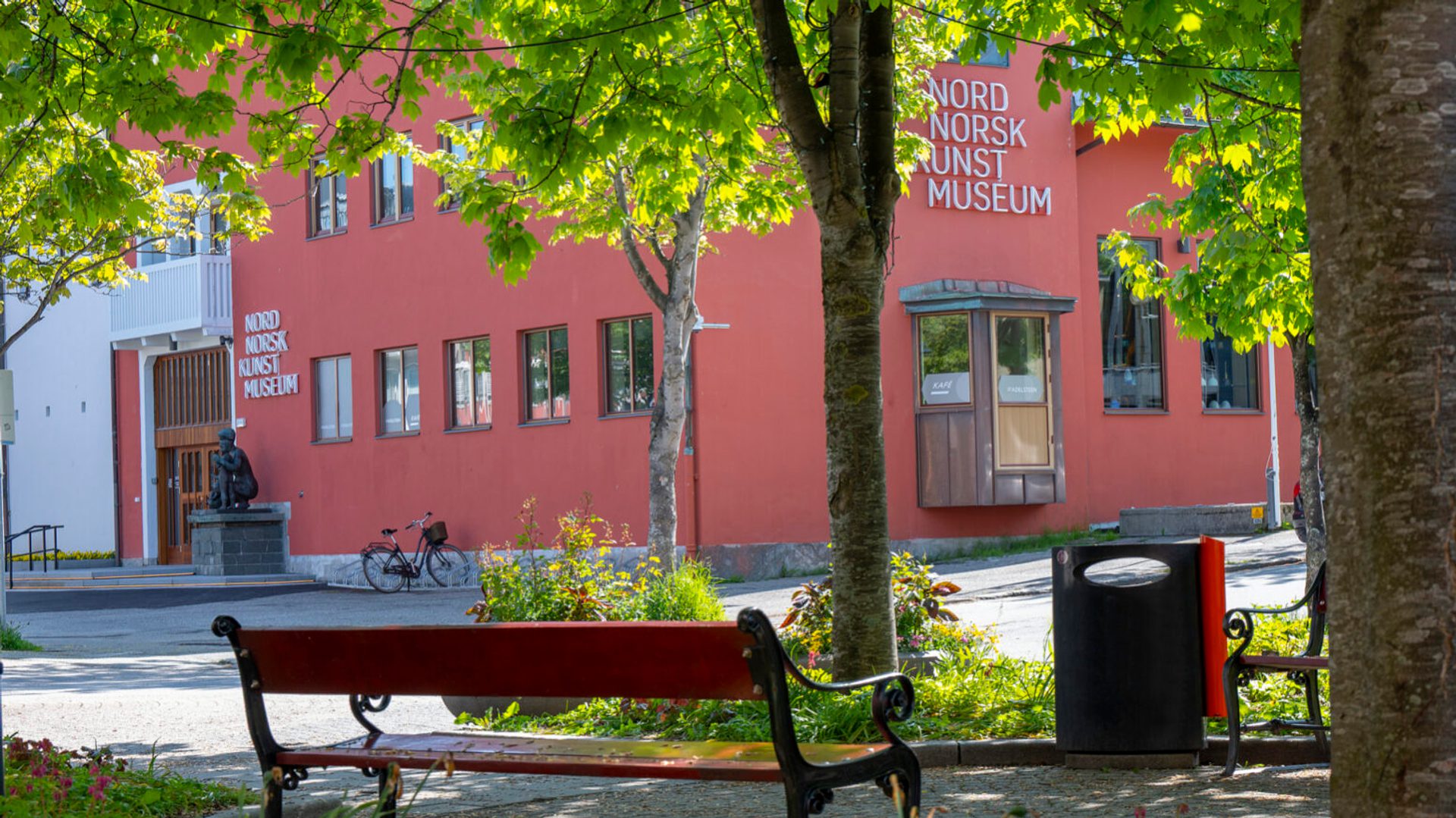Everything is Speaking – Stories in Motion


The juxtaposition of historical and contemporary works brings new perspectives and stories into the collection. The assembled artworks explore relevant social issues and convey the cultural diversity of Northern Norway and Sápmi.
The exhibition is divided into three themes: “The Gaze”, “Food Security – Food Sovereignty”, and “Fish, Gender and Sexuality”. The first section, “The Gaze”, presents artworks that open up new dialogues around some of the region’s histories. The artists in this section pose questions about society's existing power structures as manifested through the acts of looking and being looked at. It shines a spotlight on the colonial attitudes that previously portrayed other cultures as exotic and inferior, colonial attitudes which Western museums have contributed to, and that have more recently led to debates about what a museum should be. Several Sámi artists have engaged deeply in the struggle to reclaim their own culture and have created new perspectives on Sámi art through aesthetic and political interventions.
Food Security – Food Sovereignty
Questions around “Food Security and Food Sovereignty” are influenced to a large degree by standards of living, settlement patterns, environment and the climate. This theme is especially important in times marked by crises. The right to control one’s own food production through access to land and water, is often discussed in this region. A national system exists in parallel to local determinations and Indigenous rights, and these sometimes come into conflict with each other. Several of the artists included in this section have become politically active in the fight for ocean resources, sustainable coastal fishing, and locally sourced food. Sámi reindeer herding communities have had to become similarly engaged to defend their right to reindeer herding which remains a central pillar in Sámi food sovereignty.
The final section “Fish, Gender and Sexuality” explores the connection this section pose question between the ocean’s resources and power, as well as the links between fishing luck, faith and superstition, the work of fisherfolk, sexuality and gender. Some works deal with a fishing culture and traditions that was more male-dominated. These works are juxtaposed with contemporary works that challenge the historiography of this culture and question normative ideas around identity, gender and sexuality.
The title of the exhibition is taken from Sissel Mutale Bergh’s video installation Everything is Speking / Alt Snakker. The title is inspired by a phrase from the coastal area outside the Froan Islands and Fosen/Fovsen peninsula in Trøndelag/Trööndelage, where many old folk stories start with the phrase, “There once was a time when everything spoke.” The expression indicated that it is not only humans that speak, but that the land, animals and objects have a voice as well.

The Gaze
How are individuals and groups defined through the eyes of others?
In this part of the exhibition, artists visually explore stereotypes, national symbols, and how society’s power structures influence people’s attitudes toward each other.
In 1839, a French research expedition traveled to northern Norway, Sápmi and Spitsbergen to map and document the region. Aboard the ship were various researchers and the French royal court painter François-Auguste Biard, whose task was to document the journey through illustrations. The peoples of the North, and particularly the Sámi – their lives, culture and physiology – were described, illustrated, and disseminated throughout Europe. This escalated to race-based research practices wherein Sámi human remains were stolen from their graves and used to "study" their differences. The exhibition takes a critical look at these injustices that remain central in contemporary debates around repatriation of human remains and cultural heritage.
The Norwegian state’s Norwegianization policy, adopted in 1852, was another injustice committed against the Sámi and national minorities, which is thoroughly documented in the Truth and Reconciliation Commission’s report from 2023. The report gives museums, which today are charged with safeguarding cultural heritage, a special responsibility to elevate perspectives and histories that challenge earlier representations.
Several of the artists here play with staging and self-staging as a strategy to direct the gaze between external and internal identity markers, highlighting which roles these play in visual culture, both historically and in the present. There are also works which revolve around the theme of war, either in solidarity with victims of war or as self-reflexive perspectives on their own role in these conflicts.

Fish, Gender & Sexuality
How can the old northern Norwegian term “haill” be understood and nuanced in light of rorbu humor (vulgar humor associated with the dwellings of fisherfolk)), queer feminist listening to the coast’s cultural landscape, and speculative links between the formations of the landscape and Sámi etymology? This part of the opening exhibition juxtaposes newer artworks that touch on fish, gender, and sexuality against older works from Nordnorsk Kunstmuseum’s own collection, which in large part present the fishing occupation in a more homogenous way.
Adelsteen Normann (1848 Vågøya i Nordland – 1918, Kristiania (Oslo)
Fra Bodø havn / From Bodø Harbour, 1885
Olje på lerret / Oil on canvas
Rose-Marie Huuva (1943 - , bosatt i Kiruna / lives in Kiruna, Sweden)
Objekt for forskning – Hvor lenge? / Object for Research – How Long? 1999
Plexiglass, ull, jord og voks – Installasjon / Plexiglass, wool, earth and wax
Tomas Colbengtson (1957, bosatt i Stockholm / lives in Stockholm. Sweden)
De tvångsförflyttade /The Dislocated, 2020
Silketrykk, olje på polycarbonat-glass / Silkscreen, oil on polycarbonate glass
Aage Gaup (1943, Børselv – 2021, Karasjok)
Gimme Shelter, 2004
Kleberstein, tre / Soapstone, wood
Linn Rebekka Åmo (1978 - , Bodø)
Jeg ville nok sluppet deg inn / I Would Have Let You In, 2016
Håndapplikert tekstil / Hand applied textile
Einar Halfdan Berger (1890, Reinøya - 1961, Asker)
Evakuering av Finnmark / Evacuation of Finnmark
Olje på lerret / Oil on canvas
Raisa Porsanger (1988 Lakselv, bosatt i Oslo / lives in Oslo
Å inkludere ved å vise frem / Inclusion Through Exposure, 2021
Blandet materiale / Mixed media
Wendimagegn Belete (1986 - , Addis Abeba, bor og arbeider i Oslo og Addis Abeba / lives and works in Oslo and Addis Abeba, Ethiopia
Your Gaze Makes Me II, 2021
Trykk på matt fotopapir fra digitalt reprodusert og manipulert fotografi / Print on matte photo paper from digitally reproduced and manipulated photographs
Sayed Sattar Hasan (1979 - , Northampton, bosatt i Oslo / based in Oslo
Hasansens kjelke / Hasansen’s sled, 2021
Blandet materiale / Mixed materials
Hasansen på T-banen / Hasansen at The Subway, 2020
Fotografi / Photograph
François-Auguste Biard (1799, Lyon – 1882, Samois-sur-Seine)
Læstadius preker for samene / The Minister Laestadius Preaching to the Sámi 1840
Olje på lerret / Oil on canvas
Betzy Akersloot-Berg (1850 Aurskog, Akershus – 1922 Vlieland, Nederland/Netherlands)
Kystparti i Nord-Norge / Coastal Area in Northern Norway 1883
Olje på lerret / Oil on canvas
Wilhelm Otto Peters (1851 Christiania (Oslo) – 1935 Drøbak)
Sanking av sandorm / Collecting Sandworms 1884
Olje på lerret / Oil on canvas
François-Auguste Biard (1799, Lyon – 1882, Samois-sur-Seine)
Kamp med isbjørner / Fighting Polar Bear, 1839
Olje på lerret / Oil on canvas
Rune Johansen (1957, Bodø, bor og arbeider på Engeløya i Steigen / lives and works on Engeløya in Steigen)
Villy, 1997
Fotografi / Photography
Kåre Kivijärvi (Hammerfest 1938 – 1991, Kypros)
Solon med torsk / Solon with Cod, 1965
Fotografi / Photography
Are Andreassen (1957 - , Tromsø, bor i Bodø og Fleinvær / works in Bodø and Fleinvær)
Utkant III / The Outskirts III, 2000
Etsning på papir / Etching on paper
Jon Ole Andersen (Tana 1932 – 2023 Karasjok)
Nålehus / Needle holder 2002
Tre, skinn, bein, tekstil / Wood, hide, bone, textile
Dag Arnljot Rødsand (1943 i Svolvær – 1995, Jeløy)
Skrei i Olje / Cod in Oil, 1973
Fargeserigrafi på papir / Color serigraphy on paper
Máret Ánne Sara (1983 - , Kautokeino)
Gielastuvvon / Snared 2018
Brukte lassoer, lassoringer av horn og plast / Used lassos, lasso rings made of horn and plast
Aslaug Juliussen (1953 - , Lødingen, bor og arbeider i Tromsø / lives and works in Tromsø Forehandkule / ForehandSphere 2005
Reinhår, reinhorn, skinn, lim – Objekt / Reindeer hair, reindeer horn, hide, glue - Object
Lars Nils Pirak f. 1932 – d. 2008, Jokkmok
Saltripa / Salt Ptarmigan 1990
Reinhorn / Reindeer antler
Alf Magne Salo (1959 – 2013, Kåfjord)
Soltegn / Sun Sign, 2006
Akryl på lerret / Acrylic on canvas
Iver Jåks (Karasjok 1932 – 2007 Tromsø)
Offerstøttene I / Offering Pillars I, 1980
Tre, bein, hamp / Wood, bone, hamp
John Andreas Savio (1902, Bugøyfjord – 1938, Oslo)
Etter ulvene / Chasing the Wolves
Tresnitt / Woodcut
Reinkalv / Reindeer Calf, 1928
Olje på lerret / Oil on canvas
Mann med rein / Man With Reindeer
Tresnitt / Woodcut
Inghild Karlsen (1952 - , Tromsø, bosatt i Oslo / based in Oslo)
Moratorium. 1992
Installasjon, fotografi / Installation, photography
Ingunn Eldbjørg Utsi (1948 - , Repvåg)
Båra bær steinen / Wave Carries the Stone, 1987
Stein og pleksiglass / Stone and plexiglass
Eva Bakkeslett (1966 - , bosatt på Engeløya i Steigen / based in Steigen)
Pust / Breath, 2015
Video, 20 minutter / 20 minutes runtime
Geir Tore Holm (1966 - , Manndalen, bor på Skiptvet / lives and works in Skiptvet, Østfold) Nytt flagg (multer, tyttebær, blåbær) / New Flag (Cloudberries, Lingonberries, Bilberries), 2003–2020
Syltetøykrukker / Jam jars
Philipp Spillmann (1977 - , Zürich, bosatt i Oslo / based in Oslo)
Screwed, 2019
Utskåret bit av en trålkule i plast / Carved piece of a trawl ball in plastic
Thor Erdahl (1951 - , Kabelvåg r. 1951)
Trenyken I, 1990
Olje, tempera og akryl på lerret / Oil, tempera and acrylic on canvas
Elin Már Øyen Vister (1976 - iOslo, bor på Røst / based on Røst)
Røster III / Voices III, 2015
Lydinstallasjon, 1 t 18 min / Sound installation, 1 hour 18 minutes
Karl-Gustav Gjertsen (1953 - , Flakstad, bor i Narvik / lives in Narvik
Fish you were here, 1989
Linoleumsnitt / Linoleum cut print
Fingertare / Fingerkelp 2000
Linoleumsnitt / Linoleum cut print
Til oppslag om bord / To Be Announced Onboard, 1980
Linoleumsnitt / Linoleum cut print
Audar Kantun (1986 - , Bodø, bor på Nesodden/ lives on Nesodden)
Haill I, 2021
Olje på lerret / Oil on canvas
Uten tittel / Untitled, 2019
Olje på lerret / Oil on canvas
Ola Mathias Abrahamsson (1883, Stavanger - 1980, Borre)
Skårungen / The Fishing Apprentice, 1929
Olje på lerret / Oil on canvas
Alexander Jørgensen (1872, Bodø - 1922, Oslo)
Fisker / Fisherman 1897
Olje på lerret / Oil on canvas
Christian Krohg (1852 – 1925, Oslo)
Trise i arbeid / ‘Trise’ at Work, 1901
Olje på lerret / Oil on canvas
Solveig Elisabeth Ovanger (1952 - , Tromsø)
Hemisfære II / Hemisphere II, 2015
Fiskeskinn fra sei / Pollock skin
Sissel Mutale Bergh (1974 - , Trondheim)
Everything is speaking, first draft on Gorrie Guanna. 2022
Videoprojeksjon på oppspent lerret / Video projection on stretched canvas, 15:14
Ola Mathias Abrahamsson (1883, Stavanger - 1980, Borre)
Lofotfiske / Fishing in Lofoten, 1933
Olje på lerret / Oil on canvas
Matthias Stoltenberg (1799 Tønsberg – 1871 Hamar)
Udsikt Vaagøen i Districtet Lofoten / View of Vaagöen in the Lofoten District, 1837
Olje på lerret / Oil on canvas
Oscar Kristoffer Bodøgaard (1923 – 2011, Bodø)
Fiskeflåte / Fishing Fleet 1957
Olje på lerret / Oil on canvas
